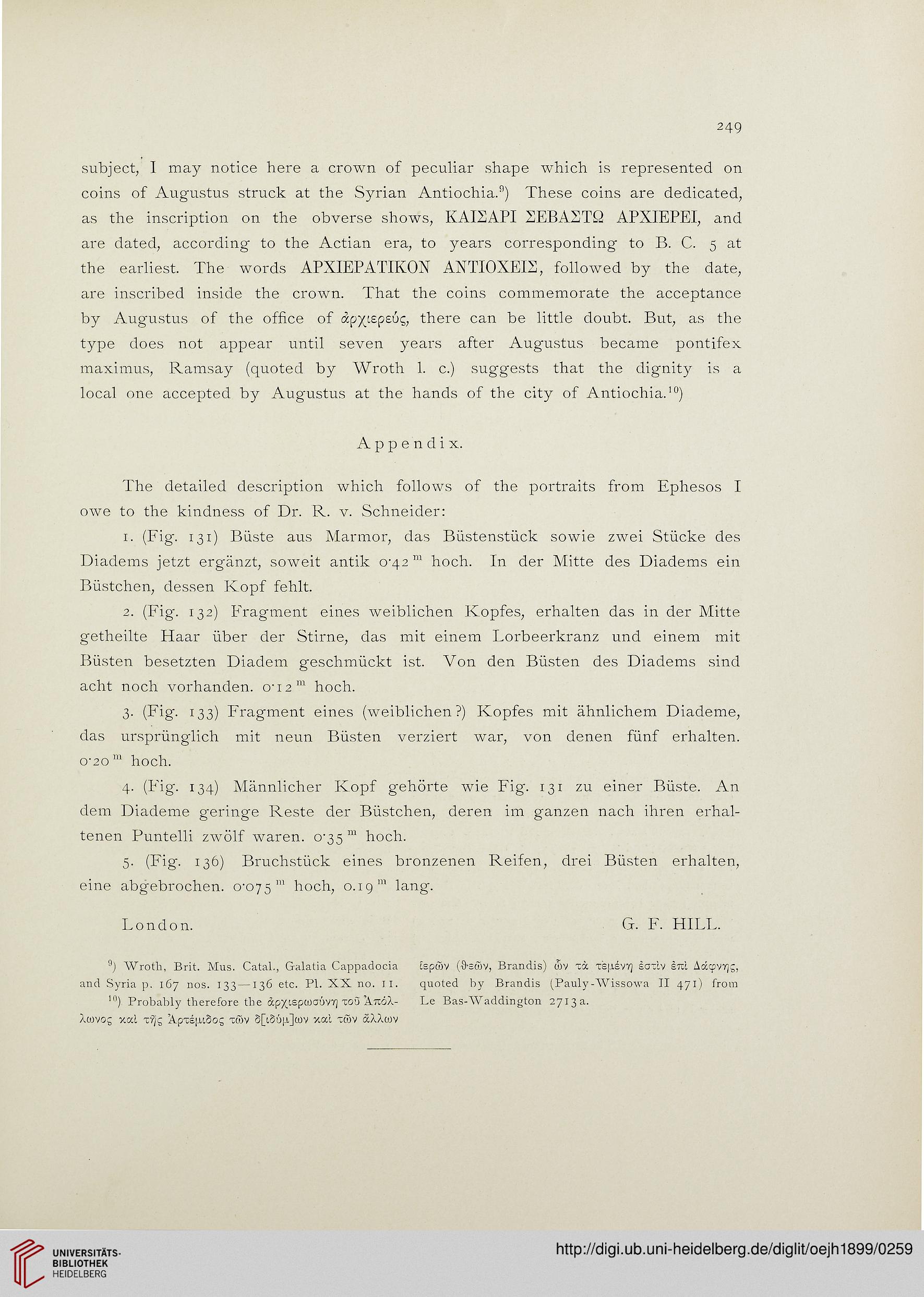249
subject, I may notice here a crown of peculiar shape which is represented on
coins of Augustus struck at the Syrian Antiochia.0) These coins are dedicated,
as the inscription on the obverse shows, KAI2API SEBASTß APXIEPEI, and
are dated, according to the Actian era, to years corresponding to B. C. 5 at
the earliest. The words APXIEPATIKON ANTIOXEIE, followed by the date;
are inscribed inside the crown. That the coins commemorate the acceptance
by Augustus of the office of ocpyiepe6 g, there can be little doubt. But, as the
type does not appear until seven years after Augustus became pontifex
maximus, Ramsay (quoted by Wroth 1. c.) suggests that the dignity is a
local one accepted by Augustus at the hands of the city of Antiochia.10)
Appendix.
The detailed description which follows of the portraits from Ephesos I
owe to the kindness of Dr. R. v. Schneider:
1. (Fig. 131) Büste aus Marmor, das Büstenstück sowie zwei Stücke des
Diadems jetzt ergänzt, soweit antik 0^42m hoch. In der Mitte des Diadems ein
Büstchen, dessen Kopf fehlt.
2. (Fig. 132) Fragment eines weiblichen Kopfes, erhalten das in der Mitte
getheilte Haar über der Stirne, das mit einem Torbeerkranz und einem mit
Büsten besetzten Diadem geschmückt ist. Von den Büsten des Diadems sind
acht noch vorhanden. o,i2m hoch.
3. (Fig. 133) Fragment eines (weiblichen?) Kopfes mit ähnlichem Diademe,
das ursprünglich mit neun Büsten verziert war, von denen fünf erhalten.
0'20 m hoch.
4. (Fig. 134) Männlicher Kopf gehörte wie Fig. 131 zu einer Büste. An
dem Diademe geringe Reste der Büstchen, deren im ganzen nach ihren erhal-
tenen Puntelli zwölf waren. o-35 m hoch.
5. (Fig. 136) Bruchstück eines bronzenen Reifen, drei Büsten erhalten,
eine abgebrochen. 0^075 m hoch, 0.19 111 lang.
London. G. F. HILF.
9) Wroth, Brit. Mus. Catal., Galatia Cappadocia tspwv (4swv, Brandis) &>v töc fepivr] saxlv ÄdcpvTjc;,
and Syria p. 167 nos. 133—136 etc. PI. XX no. II. quoted by Brandis (Pauly-Wissowa II 471) from
lfl) Probably therefore the apyispuiouv^ xoö’AxoA- Le Bas-Waddington 2713 a.
Xwvog '/.cd zrjg Äpzeiudog xwv 8[(,5ü|j.]oiv xal xcöv dAXtov
subject, I may notice here a crown of peculiar shape which is represented on
coins of Augustus struck at the Syrian Antiochia.0) These coins are dedicated,
as the inscription on the obverse shows, KAI2API SEBASTß APXIEPEI, and
are dated, according to the Actian era, to years corresponding to B. C. 5 at
the earliest. The words APXIEPATIKON ANTIOXEIE, followed by the date;
are inscribed inside the crown. That the coins commemorate the acceptance
by Augustus of the office of ocpyiepe6 g, there can be little doubt. But, as the
type does not appear until seven years after Augustus became pontifex
maximus, Ramsay (quoted by Wroth 1. c.) suggests that the dignity is a
local one accepted by Augustus at the hands of the city of Antiochia.10)
Appendix.
The detailed description which follows of the portraits from Ephesos I
owe to the kindness of Dr. R. v. Schneider:
1. (Fig. 131) Büste aus Marmor, das Büstenstück sowie zwei Stücke des
Diadems jetzt ergänzt, soweit antik 0^42m hoch. In der Mitte des Diadems ein
Büstchen, dessen Kopf fehlt.
2. (Fig. 132) Fragment eines weiblichen Kopfes, erhalten das in der Mitte
getheilte Haar über der Stirne, das mit einem Torbeerkranz und einem mit
Büsten besetzten Diadem geschmückt ist. Von den Büsten des Diadems sind
acht noch vorhanden. o,i2m hoch.
3. (Fig. 133) Fragment eines (weiblichen?) Kopfes mit ähnlichem Diademe,
das ursprünglich mit neun Büsten verziert war, von denen fünf erhalten.
0'20 m hoch.
4. (Fig. 134) Männlicher Kopf gehörte wie Fig. 131 zu einer Büste. An
dem Diademe geringe Reste der Büstchen, deren im ganzen nach ihren erhal-
tenen Puntelli zwölf waren. o-35 m hoch.
5. (Fig. 136) Bruchstück eines bronzenen Reifen, drei Büsten erhalten,
eine abgebrochen. 0^075 m hoch, 0.19 111 lang.
London. G. F. HILF.
9) Wroth, Brit. Mus. Catal., Galatia Cappadocia tspwv (4swv, Brandis) &>v töc fepivr] saxlv ÄdcpvTjc;,
and Syria p. 167 nos. 133—136 etc. PI. XX no. II. quoted by Brandis (Pauly-Wissowa II 471) from
lfl) Probably therefore the apyispuiouv^ xoö’AxoA- Le Bas-Waddington 2713 a.
Xwvog '/.cd zrjg Äpzeiudog xwv 8[(,5ü|j.]oiv xal xcöv dAXtov




